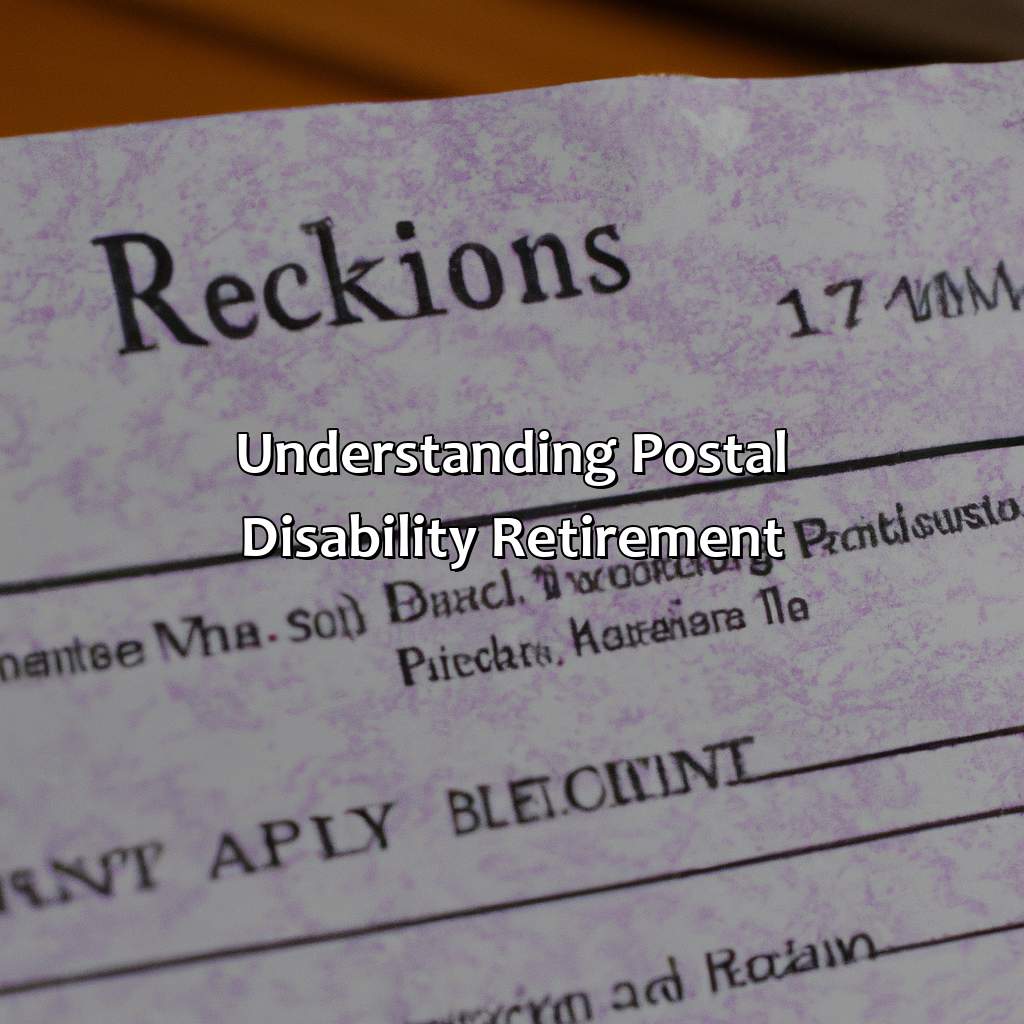How Much Is Postal Disability Retirement?
Key Takeaway:
- Postal Disability Retirement is a benefit provided by the US Postal Service to eligible employees who become disabled and unable to perform their duties. The amount of the benefit is determined by a formula that takes into account the employee’s length of service and average salary.
- To be eligible for Postal Disability Retirement, employees must have completed at least 18 months of federal civilian service and be unable to perform the essential duties of their current position due to a medical condition. They must also meet the criteria for disability as defined by the Office of Personnel Management.
- The amount of Postal Disability Retirement can be affected by a variety of factors, including the employee’s age, length of service, and the disability rating assigned by the Office of Personnel Management. Additionally, the benefit may be offset by other sources of disability income, such as Social Security Disability benefits.
Are you struggling with applying for postal disability retirement? You’re not alone – understanding the process and figuring out how much you can get can be confusing. In this article, we’ll explain how to figure out how much postal disability retirement you are eligible for.
Understanding Postal Disability Retirement
Postal Disability Retirement Explained
Postal disability retirement is a benefit offered by the United States Postal Service (USPS) to employees who become disabled and unable to perform their duties. It provides financial support to those who have suffered an injury or illness related to their work, preventing them from continuing their employment.
The amount of postal disability retirement pay depends on various factors such as the employee’s length of service and average salary. The USPS may also consider the worker’s medical condition and the severity of their impairment.
It is important to note that postal disability retirement is not a guaranteed benefit. USPS can deny applications if they find that the employee’s condition is not severe enough to prevent them from working in a suitable position within the organization.
Although some employees may be denied postal disability retirement benefits, there are success stories. For example, a postal worker with a chronic injury that prevented her from performing her duties was approved for retirement benefits after a prolonged application process. The benefits allowed her to maintain financial stability and receive the necessary medical treatment without additional stress or hardship.
Image credits: retiregenz.com by Adam Woodhock
Eligibility for Postal Disability Retirement
To qualify for Postal Disability Retirement, an individual must have a medical condition that prevents them from performing the essential functions of their job. This condition must be expected to last for a minimum of one year, and the employee must have completed at least 18 months of federal service. Additionally, the employee cannot be accommodated in their current position or in any vacant position at the same grade or pay level within their commuting area. Finally, the employee must apply for Social Security Disability benefits if they have not done so already.
It’s important to note that even if an employee meets the eligibility requirements, receiving Postal Disability Retirement is not guaranteed. Each application is evaluated on a case-by-case basis, and many factors are considered, including the employee’s medical records, job duties, and work history. However, if an individual is approved for Postal Disability Retirement, they may be eligible to receive a monthly annuity, as well as continued health insurance coverage.
It’s worth noting that applying for Postal Disability Retirement can be a complicated process, and it’s recommended that individuals work with an experienced attorney or representative who can assist them with the application and appeals process.
While the eligibility criteria for Postal Disability Retirement have remained largely unchanged over the years, there have been some notable cases that have shaped the program’s history. One such case is Brookhart v. Richardson, which established the legal standard for determining whether an individual’s disability is severe enough to qualify for benefits. Another landmark case is Adams v. Richardson, which clarified the role of medical evidence in disability determinations. These cases, and others like them, have helped to shape the Postal Disability Retirement program into what it is today.

Image credits: retiregenz.com by Yuval Woodhock
Determining the Amount of Postal Disability Retirement
When determining the amount of disability retirement for postal employees, factors such as length of service, age, and the percentage of disability are taken into account. The Annuity Computation Worksheet is used to calculate the amount, using a formula based on the high-three average salary and years of service. Other factors that may impact the amount include taxes and cost of living adjustments.
It is important to consult with a financial advisor to understand the full scope of your retirement options. Pro tip: Consider the impact of taxes and inflation on your retirement income.

Image credits: retiregenz.com by David Washington
Factors Affecting Postal Disability Retirement
Postal Disability Retirement – Understanding the Factors That Impact Your Benefits
Postal Disability Retirement is a benefit provided to eligible employees of the United States Postal Service who are unable to perform their job duties due to a medical condition. However, several factors can impact the amount of benefits that an employee may receive.
The extent and severity of the medical condition, the employee’s length of service, and the employee’s pay scale are among the critical factors that impact the benefits of Postal Disability Retirement.
The extent and severity of the medical condition are the primary factors that determine the eligibility of an employee for Postal Disability Retirement. The employee’s medical records are reviewed, and a medical examiner evaluates the employee’s ability to perform job duties. This evaluation helps determine if the medical condition impacts the employee’s ability to perform their job fully.
The employee’s length of service and pay scale are also critical factors in determining the amount of Postal Disability Retirement benefits. Employees with longer service years and higher pay scales receive more benefits than new employees with lower pay scales. The Postal Service uses a complex formula to calculate the benefits based on the employee’s salary, length of service, and disability rating.
A notable fact is that an employee must complete at least 18 months of service to qualify for disability benefits and have a present medical condition that satisfies the disability standards set by the Office of Workers’ Compensation Programs.
Knowing the factors that impact Postal Disability Retirement benefits can help employees make informed decisions, understand their eligibility, and prepare for life after leaving work due to a medical condition.
Five Facts About Postal Disability Retirement:
- ✅ Postal disability retirement generally pays less than regular retirement. (Source: PostalMag.com)
- ✅ The amount of postal disability retirement is calculated based on the employee’s length of service and average salary. (Source: USPS)
- ✅ Postal employees must apply for Social Security disability benefits in addition to postal disability retirement. (Source: PostalReporter.com)
- ✅ Postal disability retirement may be offset by workers’ compensation or other disability benefits received. (Source: PostalMag.com)
- ✅ Postal disability retirement may also provide health insurance benefits to the employee. (Source: USPS)
FAQs about How Much Is Postal Disability Retirement?
How much is postal disability retirement?
The answer to this question varies depending on several factors such as an employee’s length of service and average pay. However, a general rule of thumb is that a postal worker can expect to receive between 40-80% of their basic salary with disability retirement.
What is considered basic pay for calculating postal disability retirement?
Basic pay includes an employee’s regular salary, night differential pay, and any annual or sick leave payments they may have received in the year before they became disabled. Other forms of compensation such as overtime pay or bonuses are not included in the calculation of basic pay.
Are there any tax implications of receiving postal disability retirement?
Yes, there may be tax implications for receiving disability retirement benefits. The portion of the benefits that is attributable to the employee’s contributions will be tax-free while the portion attributable to the employer’s contributions will be taxable. It is recommended to consult a tax professional for guidance on the specific tax implications based on individual circumstances.
What is the process for applying for postal disability retirement?
Employees who wish to apply for postal disability retirement must complete a standard application form and submit it to the Office of Personnel Management (OPM) along with relevant medical documentation. It is recommended to consult with a benefits specialist to ensure that all necessary forms and documentation are completed correctly and in a timely manner.
Can a postal worker who retires due to disability return to work?
In most cases, a postal worker who retires due to disability cannot return to work for the Postal Service. However, if their condition improves and they are able to perform their old job duties with or without reasonable accommodation, they may be able to return to work.
What other benefits are available for postal workers who retire due to disability?
In addition to disability retirement benefits, postal workers who retire due to disability may also be eligible for Social Security Disability Insurance (SSDI) and Medicare benefits. These benefits may help to supplement the disability retirement benefits and provide additional financial support.







